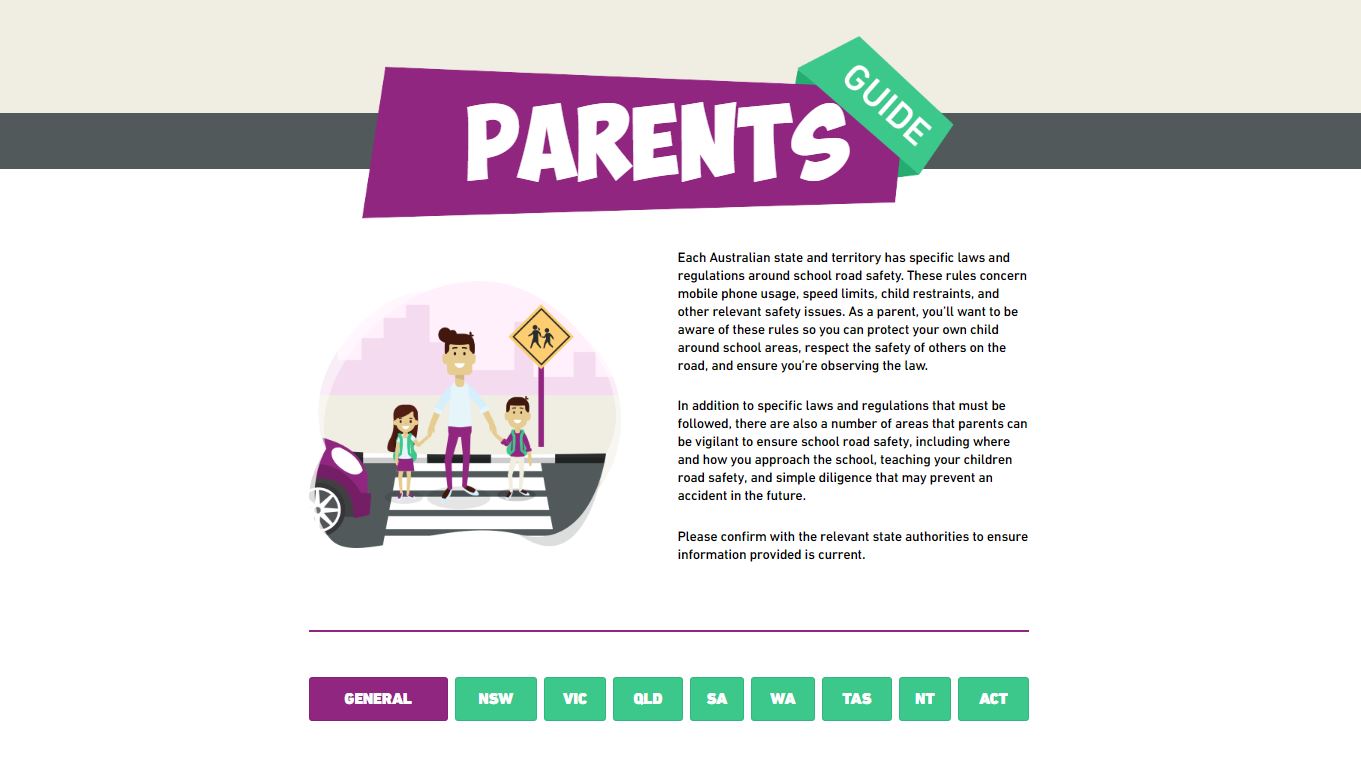Each Australian state and territory has specific laws and regulations around school road safety. These rules concern mobile phone usage, speed limits, child restraints, and other relevant safety issues. As a parent, you’ll want to be aware of these rules so you can protect your own child around school areas, respect the safety of others on the road, and ensure you’re observing the law.
In addition to specific laws and regulations that must be followed, there are also a number of areas that parents can be vigilant to ensure school road safety, including where and how you approach the school, teaching your children road safety, and simple diligence that may prevent an accident in the future.
Please confirm with the relevant state authorities to ensure information provided is current.
General School Guidelines

Please refer to the following for further general children’s safety on the road strategies, regardless of which state or territory you’re located in.
- Stop, look, listen, and thinkFrom a young age, teach children the stop, look, listen, and think approach to crossing roads.
- Young pedestriansAlways hold hands with younger children when crossing the road. Younger children can be unpredictable, so make sure they’re not allowed to wander off when you’re waiting to cross.
- Bicycles and scootersOlder kids riding bicycles and scooters to school should wear appropriate helmets. Make sure your child has a well-fitting and correctly adjusted helmet. Check they’re riding at safe speeds and taking care around pedestrians and other riders. Keep bikes and scooters well-maintained so they’re safe to use.
- VisibilityWhether you’re a driver or parent to a child who walks to school, consider visibility issues. Weather, heavy traffic, large vehicles, and double parking can impede visibility for both your child and other drivers. Take extra care and teach your child to be cautious when there’s poor visibility.For example, never double or triple park as it blocks visibility for others. A double-parked car is dangerous if your child is getting in or out as you’re right next to other vehicles. If you plan ahead and give yourself more time, you can park safely a street or two away and walk your children to the gates.
- Safety doorAssign a safety door for your drop off and pick up so the kids know which side is safe to get out (the side opening out onto the kerb).
- Learner and probationary driversProbationary drivers are more likely to be involved in accidents than learner drivers, so if possible for your family’s situation avoid having a probationary license holder pick up and drop off the kids.
Special signage
In addition to strict speed limits, your school zone can have other types of signage. The signs are there for a reason, so double check these signs so you’re obeying the law and staying safe.
Look out also for bus zone signs and children’s crossing signs. Check with your local transport authority to find out how far you need to stay away from a children’s crossing sign when stopping and parking.
National child restraint laws
All children must be safely fastened in the correct child car seat for their age and size. A child who is properly secured in an approved child car seat is less likely to be injured or killed in a car crash than one who is not.
- Under 6 monthsChildren up to the age of 6 months should be in an approved rearward-facing restraint.
- 6 months – 4 years oldIf your child is between 6 months and 4 years of age, they need to be in either a rear- or forward-facing approved child restraint with an in-built harness.If your child is under 4 years of age and your vehicle has two or more rows of seats, your child must not be seated in the front seat.
- 4 – 7 years oldChildren aged 4 years or more but under 7 years of age should be secured in a forward-facing approved child restraint with an in-built harness or an approved booster seat.They must not be seated in the front row if the vehicle has two or more rows. However, they can do so if all the back seats have been taken up by children under the age of 7 in approved restraints or booster seats.
- 7 – 16 years oldChildren aged from 7 years old but under the age of 16 are strongly recommended to use an approved booster seat if they’re too small to be restrained by a seatbelt.
- Booster seatsIf your child is seated in a booster seat, they must be restrained by a suitable lap-sash type approved seatbelt that is properly adjusted and fastened. If not, they need to be restrained with a suitable, approved child safety harness that is properly adjusted and fastened.
- Smaller childrenIf your child is too small for the recommended restraint or seat type, keep them on their current restraint until it’s safe for them to be seated the required type.
- Bigger childrenIf your child is too large for the recommended restraint or seat type, you can move them up to the next level.
View the full regulations on the Child Car Seats site here
For each states specific laws and regulations around school road safety, please go to: realinsurance.com.au/school-safety
You may also like to read:









